
Nebelwerfer
Encyclopedia
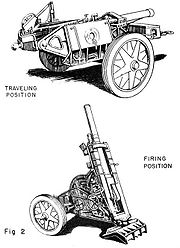
World War II
World War II, or the Second World War , was a global conflict lasting from 1939 to 1945, involving most of the world's nations—including all of the great powers—eventually forming two opposing military alliances: the Allies and the Axis...
German
Nazi Germany
Nazi Germany , also known as the Third Reich , but officially called German Reich from 1933 to 1943 and Greater German Reich from 26 June 1943 onward, is the name commonly used to refer to the state of Germany from 1933 to 1945, when it was a totalitarian dictatorship ruled by...
series of weapons originally designed to deliver chemical weapons. They were initially developed by and assigned to the Wehrmacht's so-called Chemical Troops (Nebeltruppen). This weapon was given its name as a disinformation
Disinformation
Disinformation is intentionally false or inaccurate information that is spread deliberately. For this reason, it is synonymous with and sometimes called black propaganda. It is an act of deception and false statements to convince someone of untruth...
strategy designed to lead spies into thinking that it was merely a device for creating a smoke screen. They were primarily intended to deliver poison gas and smoke shells, although a high-explosive shell was developed for their Nebelwerfers from the beginning. Initially two different mortars were fielded before they were replaced by a variety of rocket launchers ranging in size from 15 to 32 cm (5.9 to 12.6 in). The thin walls of the rockets had the great advantage of allowing much larger quantities of gases, fluids or high-explosive to be delivered than artillery or even mortar shells of the same weight. Nebelwerfers were used in every campaign of the German Army during World War II with the exception of the Balkans Campaign. One rocket was even adapted for air-to-air use against Allied bombers. The name was also used to fool observers from the League of Nations
League of Nations
The League of Nations was an intergovernmental organization founded as a result of the Paris Peace Conference that ended the First World War. It was the first permanent international organization whose principal mission was to maintain world peace...
, who were observing any possible infraction of the Treaty of Versailles
Treaty of Versailles
The Treaty of Versailles was one of the peace treaties at the end of World War I. It ended the state of war between Germany and the Allied Powers. It was signed on 28 June 1919, exactly five years after the assassination of Archduke Franz Ferdinand. The other Central Powers on the German side of...
, from discovering that the weapon could be used for explosive and toxic chemical payloads as well as the smoke rounds the name Nebelwerfer suggests.
10 cm Nebelwerfer 35
The lower muzzle velocity of a mortar meant that its shell walls were thinner than those of artillery shells and it could carry a larger payload than artillery shells of the same weight. This made it an attractive delivery system for poison gases. The U.S. Army's Chemical Warfare ServiceChemical Corps (United States Army)
The Chemical Corps is the branch of the United States Army tasked with defending against Chemical, Biological, Radiological, and Nuclear weapons...
developed their 4.2 inch chemical mortar
M2 4.2 inch mortar
-External links:* early detailed article on 4.2 mortar...
for precisely that reason and the Nebeltruppen shared that reasoning. Its first weapon was also a mortar
Mortar (weapon)
A mortar is an indirect fire weapon that fires explosive projectiles known as bombs at low velocities, short ranges, and high-arcing ballistic trajectories. It is typically muzzle-loading and has a barrel length less than 15 times its caliber....
, the 10 cm Nebelwerfer 35
10 cm Nebelwerfer 35
The 10 cm Nebelwerfer 35 was a heavy mortar used by Germany during World War II. Much like the American M2 4.2 inch mortar it was intended to deliver chemical munitions, such as gas and smoke shells. Unlike the American weapon it appears to have had an ordinary high-explosive shell from the...
, which was designed in 1934.
10 cm Nebelwerfer 40
Almost from the beginning the Army wanted more range than the 10 cm NbW 35's 3000 metres (3,280.8 yd), but troop trials of two prototypes didn't take place until May 1940. Neither was entirely satisfactory, but the best features of both were incorporated into the 10 cm Nebelwerfer 40. This was a very advanced breech-loading weaponBreech-loading weapon
A breech-loading weapon is a firearm in which the cartridge or shell is inserted or loaded into a chamber integral to the rear portion of a barrel....
with a recoil mechanism and an integral wheeled carriage. It had twice the range of its predecessor, but weighed eight times as much and cost nearly ten times as much, 1,500 RM
German reichsmark
The Reichsmark was the currency in Germany from 1924 until June 20, 1948. The Reichsmark was subdivided into 100 Reichspfennig.-History:...
vs 14,000 RM.
15 cm Nebelwerfer 41
Rocket development had begun during the 1920s and reached fruition in the late Thirties. These offered the opportunity for the Nebeltruppen to deliver large quantities of poison gas or smoke simultaneously. The first weapon to be delivered to the troops was the 15 cm Nebelwerfer 41 in 1940, after the Battle of FranceBattle of France
In the Second World War, the Battle of France was the German invasion of France and the Low Countries, beginning on 10 May 1940, which ended the Phoney War. The battle consisted of two main operations. In the first, Fall Gelb , German armoured units pushed through the Ardennes, to cut off and...
, a purpose-designed rocket with gas, smoke and high-explosive warheads. It, like virtually all German rocket designs, was spin-stabilized to increase accuracy. One very unusual feature was that the rocket motor was in the front, the exhaust venturi being about two-thirds down the body from the nose, with the intent to optimize the blast effect of the rocket as the warhead would still be above the ground when it detonated. This proved to greatly complicate manufacture for not much extra effect and it was not copied on later rocket designs. It was fired from a six-tube launcher mounted on a towed carriage adapted from that used by the 3.7 cm PaK 36 to a range of 6900 metres (7,545.9 yd). Almost five and a half million 15 cm rockets and six thousand launchers were manufactured over the course of the war.
28/32 cm Nebelwerfer 41
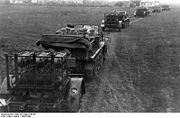
The 28/32 cm Nebelwerfer 41 rockets were introduced in 1941, before Operation Barbarossa
Operation Barbarossa
Operation Barbarossa was the code name for Germany's invasion of the Soviet Union during World War II that began on 22 June 1941. Over 4.5 million troops of the Axis powers invaded the USSR along a front., the largest invasion in the history of warfare...
. They used the same motor, but carried different warheads. The 28 centimetres (11 in) rocket had a HE
Explosive material
An explosive material, also called an explosive, is a reactive substance that contains a great amount of potential energy that can produce an explosion if released suddenly, usually accompanied by the production of light, heat, sound, and pressure...
warhead, while the 32 centimetres (12.6 in) rocket's was incendiary. The maximum range for either rocket was only 2200 metres (2,405.9 yd), a severe tactical drawback. Both could be fired from their wooden packing cases or special wooden (schwere Wurfgerät 40 - heavy missile device) or tubular metal (schwere Wurfgerät 41 (sW.G. 41)) frames. Later, a towed launcher was developed that could take six rockets. Both rockets used the same launchers, but special liner rails had to be used for the 28 cm ( in) rockets. A vehicular launch frame, the schwere Wurfrahmen 40
Wurfrahmen 40
The Wurfrahmen 40 was a German World War II multiple rocket launcher. It combined a vehicle such as the SdKfz 251 halftrack or captured ex-French Renault UE Chenillette with rocket artillery to form a more mobile and slightly more protected artillery piece than the towed Nebelwerfer...
(sWu.R. 40), was also designed to improve the mobility of the heavy rockets. These were normally mounted on the sides of Sd.Kfz. 251 half-tracks, but they were also adapted for several different captured French tracked vehicles. The sWuR 40 was nicknamed the Stuka-zu-Fuß ("Foot Stuka"). Over six hundred thousand rockets and seven hundred launchers, excluding the sW.G. and sWu.R. firing frames, were made during the war. More than fifteen thousand frame launchers were built beginning in 1940.
21 cm Nebelwerfer 42
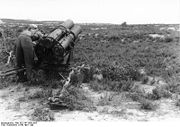
The 21 cm Nebelwerfer 42 rocket was introduced in 1942 with a longer range (7850 metres (8,584.9 yd)) and a simpler design than the smaller 15 cm rocket. It only had a high-explosive warhead. It was fired from a five-tube launcher that used the same carriage as the smaller weapon. Liner rails were made to allow it to fire the smaller 15 cm rocket. It was also adapted for use by the Luftwaffe
Luftwaffe
Luftwaffe is a generic German term for an air force. It is also the official name for two of the four historic German air forces, the Wehrmacht air arm founded in 1935 and disbanded in 1946; and the current Bundeswehr air arm founded in 1956....
to break up Allied
Western Allies
The Western Allies were a political and geographic grouping among the Allied Powers of the Second World War. It generally includes the United Kingdom and British Commonwealth, the United States, France and various other European and Latin American countries, but excludes China, the Soviet Union,...
bomber formations in 1943 as the Werfer-Granate 21. Over four hundred thousand rockets and fourteen hundred launchers were completed.
30 cm Nebelwerfer 42
The last German-designed rocket to be introduced was the 30 cm Nebelwerfer 42 in 1943. This was intended to replace the 28 and 32 cm rockets which proved to have too short a range. Advances in propellant chemistry also reduced its smoke signature. It could be fired from all of the same platforms as the older rockets and many of the older launchers were converted to be used by the newer rocket by installing adapter rails although it had its own purpose-designed launcher, the 30 cm Raketenwerfer 5630 cm Raketenwerfer 56
The 30 cm Raketenwerfer 56 was a German multiple rocket launcher used in the Second World War. It served with units of the Nebeltruppen, the German equivalent of the U.S. Army's Chemical Corps. Just as the Chemical Corps had responsibility for poison gas and smoke weapons that were used instead to...
, as well. Less than two hundred thousand rockets and seven hundred launchers were built during the war.
8 cm Raketen-Vielfachwerfer
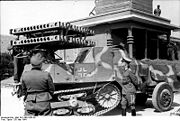
Waffen-SS
The Waffen-SS was a multi-ethnic and multi-national military force of the Third Reich. It constituted the armed wing of the Schutzstaffel or SS, an organ of the Nazi Party. The Waffen-SS saw action throughout World War II and grew from three regiments to over 38 divisions, and served alongside...
decided to copy the Soviet 82 millimetres (3.2 in) M-8 Katyusha rocket launcher as the twenty-four-rail 8 cm Raketen-Vielfachwerfer. Its fin-stabilized rockets were cheaper and easier to manufacture than the German spin-stabilized designs and used cheap launch rails. It was also capable of using the considerable stocks of captured Soviet rockets. Separate production lines were set up under party control as the Army refused to convert any of its existing factories, but not many actually appear to have been made. Production quantities are unknown, but photographic evidence shows the launcher mounted on lightly armored versions of the Sd.Kfz. 4
SdKfz 4
The SdKfz 4 Gleisketten-Lastkraftwagen , nicknamed Maultier was a family of half-tracks developed during World War II by Germany.-Development:...
"Maultier" and the captured French SOMUA MCG
SOMUA MCG
The SOMUA MCG was an artillery tractor and recovery vehicle of the French forces during World War II.It was used to tow medium artillery pieces such as the 155 mm mle 1917 howitzer and the 105 mm mle 1936 field gun, as well as their specific ammunition trailers...
half-track.
Panzerwerfer
In order to improve the mobility of the Nebelwefer units a ten-tube 15 centimetres (5.9 in) launcher was mounted on a lightly armored Sd.Kfz. 4 "Maultier" half-trackHalf-track
A half-track is a civilian or military vehicle with regular wheels on the front for steering, and caterpillar tracks on the back to propel the vehicle and carry most of the load. The purpose of this combination is to produce a vehicle with the cross-country capabilities of a tank and the handling...
chassis as the 15 cm Panzerwerfer 42 auf Selbstfahrlafette Sd.Kfz. 4/1
SdKfz 4
The SdKfz 4 Gleisketten-Lastkraftwagen , nicknamed Maultier was a family of half-tracks developed during World War II by Germany.-Development:...
(based on the Opel
Opel
Adam Opel AG, generally shortened to Opel, is a German automobile company founded by Adam Opel in 1862. Opel has been building automobiles since 1899, and became an Aktiengesellschaft in 1929...
Maultier, or "mule", half-track). Three hundred of these were produced, split evenly between launchers and ammunition carriers (which were identical except for the launcher). These were superseded in production by the 15 cm Panzerwerfer 42 auf Schwerer Wehrmachtsschlepper
Schwere Wehrmachtschlepper
The Schwerer Wehrmachtschlepper , or sWS for short, was a German World War II half-track flat-bed cargo vehicle used in various roles between 1943 and 1945. The unarmored models were used as supply vehicles and as tractors to haul things...
(Panzerwerfer auf SWS) which had improved cross-country mobility and greater ammunition storage than the "Maultier". The exact number built of the latter weapon are unknown, but evidence suggests that fewer than one hundred were completed before the end of the war.
Air-to-air adaptation (Werfer-Granate 21 rocket)
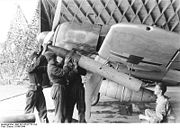
Air-to-air rocket
An air-to-air rocket or air interception rocket is an unguided projectile fired from aircraft to engage other flying targets. They were used briefly in World War I to engage enemy observation balloons and in and after World War II to engage enemy bombers...
version of the projectile used in the Nebelwerfer 42 and was first used in the defense of Schweinfurt
Schweinfurt-Regensburg mission
The Schweinfurt–Regensburg mission was an air combat battle in World War II. A strategic bombing attack flown by B-17 Flying Fortresses of the U.S. Army Air Forces on August 17, 1943, it was conceived as an ambitious plan to cripple the German aircraft industry...
on 17 August 1943. The Wfr. Gr. 21 was mounted on Messerschmitt Bf 109
Messerschmitt Bf 109
The Messerschmitt Bf 109, often called Me 109, was a German World War II fighter aircraft designed by Willy Messerschmitt and Robert Lusser during the early to mid 1930s...
and Focke-Wulf Fw 190
Focke-Wulf Fw 190
The Focke-Wulf Fw 190 Würger was a German Second World War single-seat, single-engine fighter aircraft designed by Kurt Tank in the late 1930s. Powered by a radial engine, the 190 had ample power and was able to lift larger loads than its well-known counterpart, the Messerschmitt Bf 109...
fighter
Fighter aircraft
A fighter aircraft is a military aircraft designed primarily for air-to-air combat with other aircraft, as opposed to a bomber, which is designed primarily to attack ground targets...
s (one launch tube under each wing) and on the Messerschmitt Bf 110
Messerschmitt Bf 110
The Messerschmitt Bf 110, often called Me 110, was a twin-engine heavy fighter in the service of the Luftwaffe during World War II. Hermann Göring was a proponent of the Bf 110, and nicknamed it his Eisenseiten...
and Messerschmitt Me 410
Messerschmitt Me 410
The Messerschmitt Me 410 Hornisse was a German heavy fighter and Schnellbomber used by Luftwaffe during World War II. Though essentially a straightforward modification of the Me 210, it was designated the Me 410 to avoid association with its notoriously flawed predecessor.-Design and...
heavy fighter
Heavy fighter
A heavy fighter is a fighter aircraft designed to carry heavier weapons or operate at longer ranges. To achieve acceptable performance, most heavy fighters were twin-engined, and many had multi-place crews....
s (two launch tubes under each wing) and was the first air-to-air rocket used by the Luftwaffe
Luftwaffe
Luftwaffe is a generic German term for an air force. It is also the official name for two of the four historic German air forces, the Wehrmacht air arm founded in 1935 and disbanded in 1946; and the current Bundeswehr air arm founded in 1956....
. Photographic evidence indicates that the Hungarians fitted three tubes under each wing of some of their twin-engined Me 210 Ca-1 heavy fighters. The rockets were used to break up Allied
Allies of World War II
The Allies of World War II were the countries that opposed the Axis powers during the Second World War . Former Axis states contributing to the Allied victory are not considered Allied states...
bomber
Bomber
A bomber is a military aircraft designed to attack ground and sea targets, by dropping bombs on them, or – in recent years – by launching cruise missiles at them.-Classifications of bombers:...
formations in order to enable more effective German fighter attacks against the scattered Allied aircraft. However, the high drag
Drag (physics)
In fluid dynamics, drag refers to forces which act on a solid object in the direction of the relative fluid flow velocity...
caused by the launchers reduced the speed and maneuverability of the launching aircraft, a handicap which could prove fatal if Allied fighters were encountered. Also, the launch tube's underwing mounting setup, which usually aimed the projectile at about 15º upwards from level flight to counter the considerable ballistic drop of the projectile in flight after launch, added to the drag problem.
Use in combat
After the crew had loaded and aimed the launcher, they had to take cover 10 to 15 m (10.9 to 16.4 yd) away to avoid the exhaust flames, and would fire the rockets with an electric switch. After firing, however, a long streak of smoke was visible from a considerable distance, leaving the Nebelwerfer vulnerable to counter-battery fireCounter-battery fire
Counter-battery fire is a type of mission assigned to military artillery forces, which are given the task of locating and firing upon enemy artillery.-Background:...
. It was therefore necessary to relocate the launcher and crew
Shoot-and-scoot
The term shoot and scoot refers to an artillery tactic of firing at a target and then immediately moving away from the location where the shots were fired. The reason for this is to avoid counter-battery fire - fired by enemy artillery or delivered by attack aircraft and helicopters, in order to...
as soon as possible after firing. The loud, shrill howling noise of the incoming rockets led American
United States Army
The United States Army is the main branch of the United States Armed Forces responsible for land-based military operations. It is the largest and oldest established branch of the U.S. military, and is one of seven U.S. uniformed services...
soldiers in the Sicily campaign
Allied invasion of Sicily
The Allied invasion of Sicily, codenamed Operation Husky, was a major World War II campaign, in which the Allies took Sicily from the Axis . It was a large scale amphibious and airborne operation, followed by six weeks of land combat. It launched the Italian Campaign.Husky began on the night of...
to give it the nicknames "Screaming Meemie" and "Moaning Minnie".
Organization
Generally, mortars of the Nebeltruppen were organized into batteries of six or eight mortars, three batteries per battalion. The towed rocket launchers had six launchers per battery, three batteries per battalion. Usually, three battalions formed a regiment. Midway through the war brigades were formed, each with two regiments. Each regiment was sometimes reinforced with a Panzerwerfer battery of 6-8 vehicles. From 1942 their designations changed from Nebelwerfer to simply Werfer.As part of the general expansion of the Waffen-SS
Waffen-SS
The Waffen-SS was a multi-ethnic and multi-national military force of the Third Reich. It constituted the armed wing of the Schutzstaffel or SS, an organ of the Nazi Party. The Waffen-SS saw action throughout World War II and grew from three regiments to over 38 divisions, and served alongside...
it began to form its own Werfer units in 1943, although they never formed any unit bigger than a battalion. These were organized much the same as their Army counterparts.
Organizational history
The 1st, 2nd and 5th Nebelwerfer Battalions, each equipped with twenty-four 10 cm Nbw 35 mortars in three batteries, were ready when the Germans invaded PolandInvasion of Poland (1939)
The Invasion of Poland, also known as the September Campaign or 1939 Defensive War in Poland and the Poland Campaign in Germany, was an invasion of Poland by Germany, the Soviet Union, and a small Slovak contingent that marked the start of World War II in Europe...
in September 1939. The 1st and 2nd Battalions participated in that campaign while the 5th remained in Western Germany. One battery of Artillery Regiment 222 was converted to 10 cm NbW 35s and participated in the Norwegian Campaign. By May 1940 five more battalions had been formed, all equipped with 10 cm NbW 35 mortars, filling out the sequence from 1 to 8, but only the first five were combat ready when the Battle of France
Battle of France
In the Second World War, the Battle of France was the German invasion of France and the Low Countries, beginning on 10 May 1940, which ended the Phoney War. The battle consisted of two main operations. In the first, Fall Gelb , German armoured units pushed through the Ardennes, to cut off and...
began on 10 May 1940.
The first 15 cm NbW 41 rocket launchers were delivered in July 1940, forming three new regiments, the 51st though 53rd Nebelwerfer Regiments, each with three battalions. The 54th Regiment was formed from the 1st and 7th Nebelwerfer Battalions. The Nebel-Lehr Regiment was formed from the Nebeltruppen school in Celle
Celle
Celle is a town and capital of the district of Celle, in Lower Saxony, Germany. The town is situated on the banks of the River Aller, a tributary of the Weser and has a population of about 71,000...
on 29 April 1941 with two battalions, one each with 10 cm NbW 35 mortars and 15 cm NbW 41 rockets. The independent Nebelwerfer Battalions retained their mortars with the exception of the 8th, which received rockets before Operation Barbarossa
Operation Barbarossa
Operation Barbarossa was the code name for Germany's invasion of the Soviet Union during World War II that began on 22 June 1941. Over 4.5 million troops of the Axis powers invaded the USSR along a front., the largest invasion in the history of warfare...
. The only way of differentiating the units equipped with mortars during this period from those with rockets being the "d." or "do." suffix added to the designations of the rocket-equipped units. Beginning in November 1941 the eight Decontamination Battalions were fully equipped with 28/32 cm NbW 41 rockets (some had sW.G. 40 and 41 launching frames earlier) and reorganized into three Heavy Werfer Regiments.
During early 1942 the 10th Mountain Werfer Battalion was formed from the 104th Decontamination Battalion and sent to 20th Mountain Army in Finland. In late 1943 Werfer-Battalion 11 was organized from two batteries already in Finland, including the battery from Artillery Regiment 222 that participated in the invasion of Norway. A new Panzerwerfer battery was sent from Germany to be its third battery at the same time. Both battalions retreated into Northern Norway after the Finnsh
Finland
Finland , officially the Republic of Finland, is a Nordic country situated in the Fennoscandian region of Northern Europe. It is bordered by Sweden in the west, Norway in the north and Russia in the east, while Estonia lies to its south across the Gulf of Finland.Around 5.4 million people reside...
armistice
Moscow Armistice
The Moscow Armistice was signed between Finland on one side and the Soviet Union and United Kingdom on the other side on September 19, 1944, ending the Continuation War...
in September 1944 after the Vyborg–Petrozavodsk Offensive
The 9th Nebelwerfer Battalion was given rockets, redesignated as the first battalion of Werfer-Regiment 71 and sent to North Africa late that year. Most of the second battalion were sent to Tunisia in early 1943 where they surrendered in May. The remainder of the regiment fought in Sicily and mainland Italy for the rest of the war.
Panzerwerfer batteries began to reinforce the Werfer Regiments beginning in mid-1943 and the regiments were paired into brigades beginning in early 1944. In late 1944 the brigades were redesignated as Volks-Werfer Brigades although no organizational changes occurred. A total of fifteen Werfer and Volks-Werfer Brigades were formed, plus one Positional Werfer Brigade (Stellungs-Werfer-Brigade) during the war.
External links
- U.S. World War II Intelligence Report on Nebelwerfer 41
- Video of Nebelwerfer launchers
- Luftwaffe manual for Werfer-Granate 21 rocket use on late model Fw 190 As-in German
- Army Nebelwerfer Units on Panzerkeil
- Independent Nebelwerfer Units of the Waffen-SS on Panzerkeil
- Nebeltruppe on Lexikon der Wehrmacht

